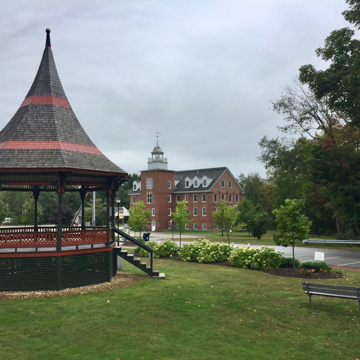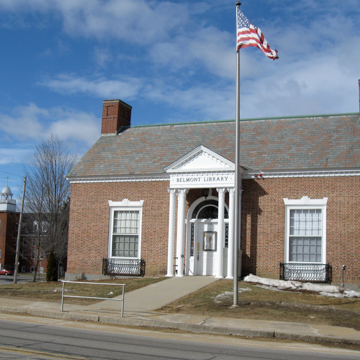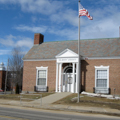Factory Village is located in the valley of the Tioga River in the southeastern corner of the town of Belmont. The primary historical focus of the village and its raison d'être has long been the textile factory complex on Mill Street, set back from the west side of Main Street on the east bank of the river. Fortunately, the oldest and most noteworthy portion of the complex, the former Fenwick Hosiery Company Mill still stands, the bulk of the complex having fallen victim to demolition and fire in the twentieth century. This plain, functional, medium pitched-roof structure was initially built for the Gilmanton Village Manufacturing Company in 1833–1834 and was first employed in spinning cotton and weaving cotton sheeting. Like the Belknap Mill in Laconia (see BE16), the Belmont building was constructed of substantial exterior brick bearing walls, and a heavy, fire-resistant, interior wooden framing of massive girders, lighter joists, and floor planking. After the acquisition of the mill by Moses Sargent Sr. of Laconia in 1865, it was converted for the purpose of hosiery knitting. By c. 1900, as part of a general expansion of the complex, the original mill had been raised from three stories with attic, to a full four stories under a shallow pitched roof, and the initial front, central wooden stair was replaced with a bulky, square brick stair tower crowned by the three-stage cupola atop the first roof. After its closure in 1970, the mill sat dilapidated and deteriorating for over two decades, suffering from major fire damage in 1992 and threatened with possible demolition. Then, from 1996 to 1998, the structure was stabilized and restored, the added story and roof replaced by a pitched roof with dormers resembling the original. Today it accommodates senior services, including a medical office and restaurant, and attracts deserved attention as one of New Hampshire’s oldest textile mills.
Just to the east of the mill, where Mill Street intersects with Main Street, is the Belmont Public Library, properly reputed to be one of the finest small public libraries in the Lakes Region, and one of this area’s most outstanding examples of the Colonial Revival style. Established in 1893, the town library was combined with other offices in two buildings until 1927 when George E. and Walter F. Duffy, the co-owners of the Belmont Hosiery Mill, offered to give the town a separate, fully equipped and endowed library facility. For the design of the library, the Duffys commissioned the Hanover, New Hampshire, architectural firm of Harry A. Wells and Archer H. Hudson, recognized for their distinguished work for Dartmouth College. Dedicated in February 1928, the new building, though modest in size and embellishment, makes a forceful aesthetic statement. Typically symmetrical, with tall, matching end chimneys, this well-maintained brick wall and pitched slate roof structure exhibits as its principal design feature a classical front facade portico with elegant, tall fluted columns and pilasters, an entablature, and a perfectly proportioned pediment. Shielded by the portico is a finely articulated semicircular arched doorway with leaded, glass sidelights and a transom window set within a brick arch with keystone. Meriting further notice in all wall surfaces are the “cast-stone” decorated window lintels with their central keystones and radiating end blocks. On the interior, the library proper is the most impressive and largest space with its paneled walls lined with bookcases, its arched entry, the grand fireplace with chimney breasts, and the high ceiling with its heavily dentiled cornice.
Approximately 150 feet west of the library adjacent to the bend in Mill Street is a marvelous c. 1885 wooden bandstand, one of New Hampshire’s best examples of a characteristic nineteenth-century American architectural form. Relocated in 1927 when the Belmont Public Library was erected on its original site, this elaborate and respectfully preserved, open, octagonal structure displays a lavish array of balustrade, post, frieze, and bracket forms associated with the flamboyant Eastlake style. It is capped by an eye-catching concave, shingled spire roof. The Belmont bandstand, like other around the state, was inspired by popular town brass band movement after the Civil War.

















